
Search engine optimization is the art of making your website rank higher in search results. It is a proven method to drive massive traffic from organic search queries and generate more leads.
This can be done with the help of different tactics. One of these tactics is creating content that is SEO-optimized. Find a topic that is in high demand and develop content that readers and search engines alike will love. It will help you attract more page visits and boost conversions.
Today, we’re going to talk about the importance of search engine optimization and how we can create SEO-friendly content to increase visibility.
Table of Contents
What is Semrush?

Semrush is an all-in-one platform for SEO, competitor analysis, content marketing, and social media sharing. It is an essential tool for website owners to find new possibilities and increase traffic.
They have the world’s largest database of 24.7 billion keywords, 43 trillion backlinks, and 808 billion domain profiles that update every day to deliver the most accurate information to more than 10 million customers around the globe.
Find topics that can bring more traffic to your pages, optimize content for search engines, and promote them on social networks at a pre-defined schedule. Track your search ranking positions and spy on competitors to identify their growth secrets. You can do all these things with an active Semrush account.
Semrush can audit your websites and backlinks frequently to detect complex SEO issues as well as bad backlinks on your site. It will also guide you on how to solproblemsngs to regain lost rankings and boost your income.
How to write an SEO-Optimized Blog Post and Rank on Top 10 Search Results?
Let us get started.
1. Keyword research
Keyword research is a crucial step in the SEO process, but it doesn’t have to be extremely time-consuming. In fact, if you already have a blog post idea, you can usually get a good idea of what keywords you should be using from your brainstorming session.
If you’re not sure where to start, or you want a little more direction, there are a number of free and paid tools you can use to find the keywords your audience is already searching for.
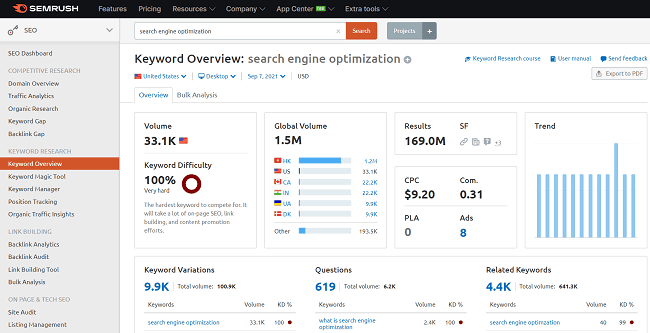
Semrush is my favorite tool to find less-competitive and profitable keywords. They have world’s largest keyword database with 20B keywords and 20M ideas for each keyword from 142 geographical locations. Thus, it serves maximum content opportunities for your business or blog.
Apply filters to uncover traffic-generation keywords and make more revenue from ad clicks. Prepare a list of related keyword phrases and questions, so you can include them in the content to maximize ranking chances.
Semrush is a great choice to detect trending keywords in your niche with ranking difficulty and competition levels. It will also list top 100 pages ranking for the keyword in Google SERPs. Open top 10 pages in a new tab to collect important points and create an evergreen content on your blog.
Monitor their individual metrics to spy on all ranking keywords and authoritative backlinks. Customize your SEO strategies to outrank competitors and obtain their traffic accordingly.
2. Keyword research vs topic research
First, let us define what these two terms mean. Keyword research is finding the right keyword(s) for your content to make it rank higher in search engines. Topic research is finding the right topic to write your content around to make it more readable and useful.
When you engage in keyword research, you are looking for the right keyword(s) to get your content ranked higher in the search engines. By using specific keywords, you are hoping that it will bring you more traffic.
Topic research, on the other hand, is about choosing the right topic to write your content around. With this, you are hoping that your content will be helpful to your target audience.
Open your Content Marketing Toolkit on Semrush and search for a topic. For instance, search for ‘Search engine optimization’ to collect ideas.
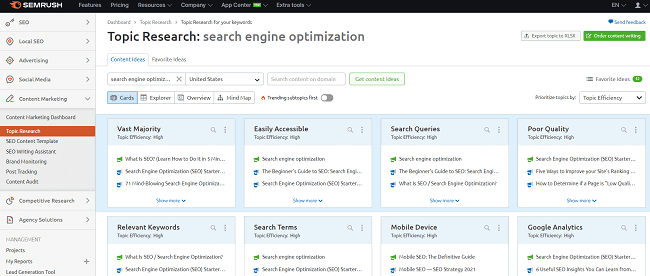
Semrush will connect to search engines to retrieve data. It will display top performing articles across categories using cards. Filter results by search volume, topic efficiency, and difficulty level.
Expand a card to view all suggestions in the category.

It will show sub topic search volume, difficulty rate, and topic efficiency on the top. Tap the ‘+’ icon that appears next to each title to add it to your favorites. Semrush will create a new card using them. When finished selecting topics, shift to Favorite Ideas tab.

From there, you can create an SEO Content Template for the topic or schedule the task for a future date. If there are multiple authors, click the last icon to create a Trello card and assign an author to ensure that the content is prepared within the deadline.
3. Create an SEO Content Template
Select the first option to create an SEO Content Template around the topic. It will redirect you to another screen.
Add more related keywords and change the target audience if needed. Click ‘Create SEO Template’ button again.
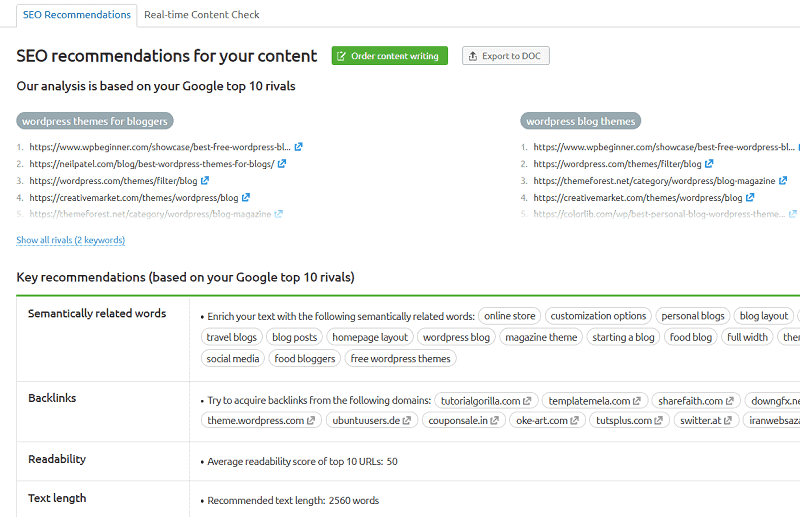
Semrush will analyze top 10 ranking pages for the keyword and suggest keywords that you need to include in the content. It will also suggest the best backlink sources and text length to rank higher in SERPs.
Their basic recommendations cover the following points,
- Page title
- Target keywords
- H₁
- Meta description
- Average readability score
Next, you have two options. Either order content writing from expert authors on Semrush Marketplace or open SEO Writing Assistant to create an SEO-optimized content easily.
Semrush content writing services start at $40 per article. They will also handle email newsletter copies, infographics, stock-free images, videos, and much more. The content will be optimized for relevant keywords to drive maximum traffic from organic search queries.
If you are going to create content yourself, just go to the next step.
4. Use SEO Writing Assistant
SEO Writing Assistant helps you to create SEO-friendly articles through real-time content checks and instant SEO recommendations. It reads texts as you type to make sure the content is original and properly optimized for the target keywords. Follow on-screen suggestions to improve your readability score and attract visitors from all possible sources.
There are three ways to enable real-time SEO checks on your content,
- Semrush dashboard
- WordPress plugin
- Google Docs add-on
Open SEO Writing Assistant from the left pane of Content Marketing Dashboard and locate your SEO Content Template from the list. Tap ‘Open in Semrush’ button to begin.
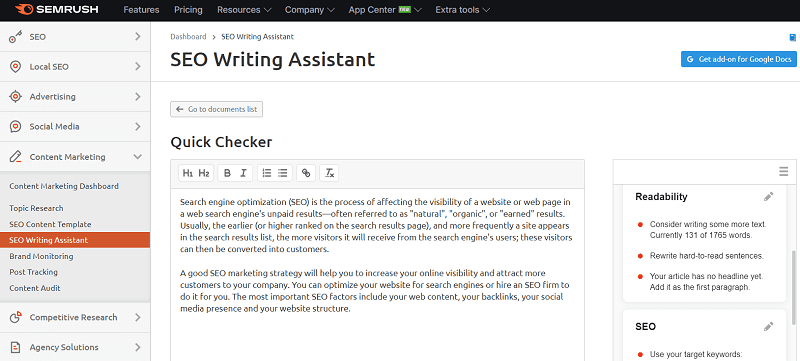
Enter your post title and content. Semrush analyzes them based on the given target keywords. It runs several SEO tests to ensure that the post is easy to read and keyword rich.
Consider the following points to craft SEO-optimized content and boost search rankings,
- Write short sentences and paragraphs
- Add relevant images to attract visitors
- Optimize images for target keywords
- Point to external sources with do-follow link attributes
- Add internal links to send traffic between pages
- Fix grammatical mistakes with an online tool like Grammarly
- Check for plagiarism
SEO Writing Assistant has a built-in plagiarism checker to ensure the originality of your content. When finished, tap the Check button (Under Originality) to check for plagiarism. It will dig into the internet database and display results in a few moments.
If you are using WordPress, install Semrush SEO Writing Assistant to enable SEO checks on your post editor. It also works with Google Docs to get instant recommendations and create SEO-friendly articles in simple steps. Finally, publish the content as usual.
5. Track keywords
Semrush allows you to track keywords through multiple channels with daily ranking updates. They are,
- Organic Research
- Position Tracking
Organic Research is an incredible tool to track organic keywords of any website. Sign in to Semrush and visit SEO dashboard. Enter your website URL to view ranking keywords.
Locate ‘Top Organic Keywords’ section and click on View all.
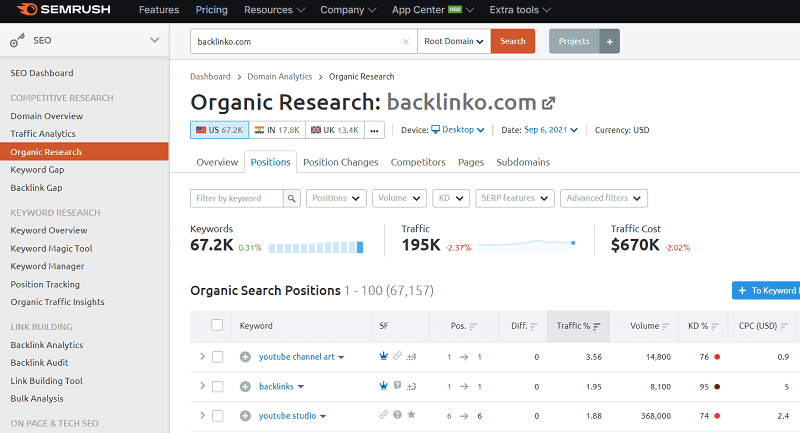
Now you will see all ranking keywords with daily position variations, search volume, traffic percentage, and CPC rate.
Open Advanced filters and search for specific keywords to watch them closely.
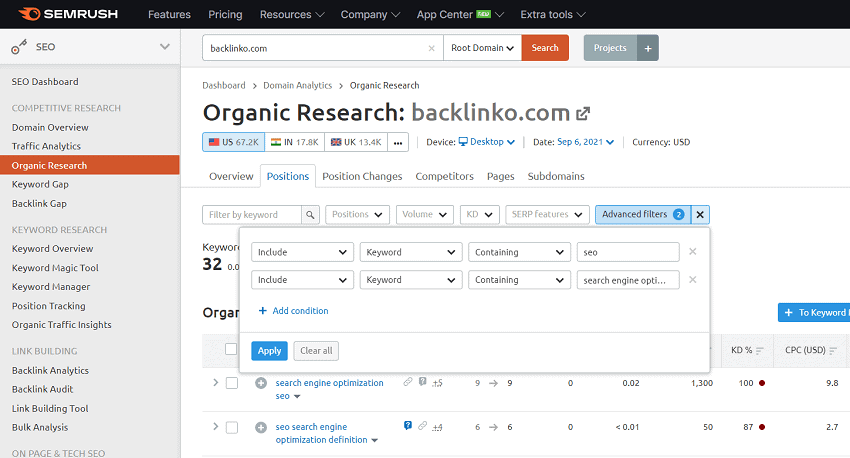
Position Tracking is another tool to monitor your website keywords with weekly email notifications.
If your keyword rankings are declining or not improving for a few days, you have to do some extra work to improve visibility. It includes,
- Update the content with more information. Read top 10 ranking pages to get content update ideas.
- Create new high-authority backlinks. Write guest posts and use social bookmarking communities like Quora to market your content effectively and rank higher in SERPs.
Conclusion
Semrush is an all-rounder SEO tool to detect keywords having huge demands and develop a compelling article around the topic. Their SEO Content Template analyzes top ranking pages and gives valuable content suggestions such as related keywords, the best backlink sources, recommended text length, etc. to get more love from search engines.
Even though, it may be difficult for most of us to create an SEO-optimized article without using an on-page SEO checker like SEO Writing Assistant. It is easy to use and supports popular platforms including WordPress and Google Docs.
It reads your text in real-time and guide you on how to create an SEO-friendly blog post that can bring massive traffic from search engines. Follow recommendations to write high-quality content around your selected topic and rank in top 10 search results.
Click here to sign up for a Semrush free-trial and use all their premium tools for free (Semrush SEO Content Template + SEO Writing Assistant + Keyword Magic + Position Tracking & many others included)




Such amazing nice and great article about the content. thanks for sharing the great ideas.
keep your good blogging and sharing the ideas with us. I still waiting for your next ideas.